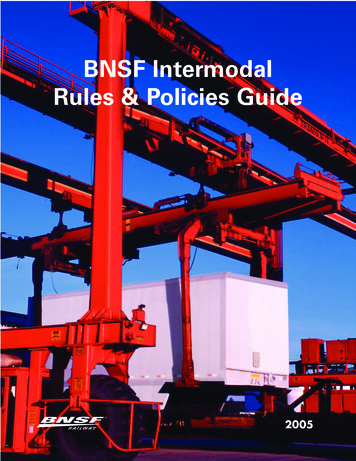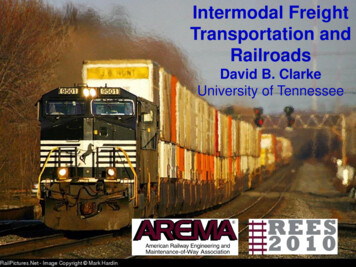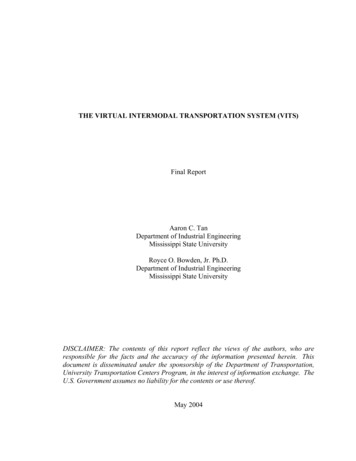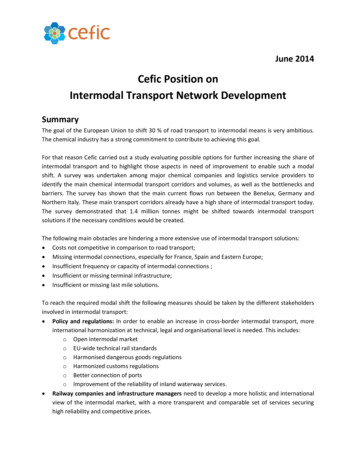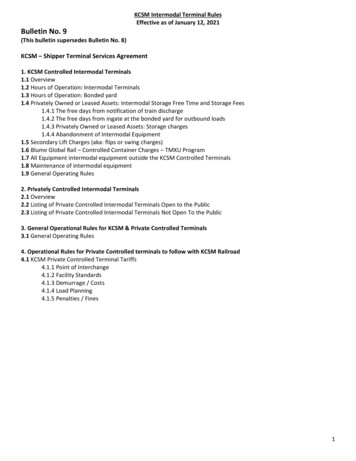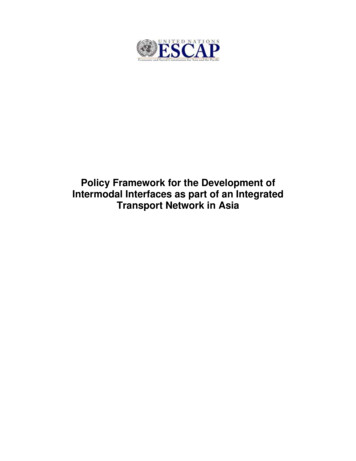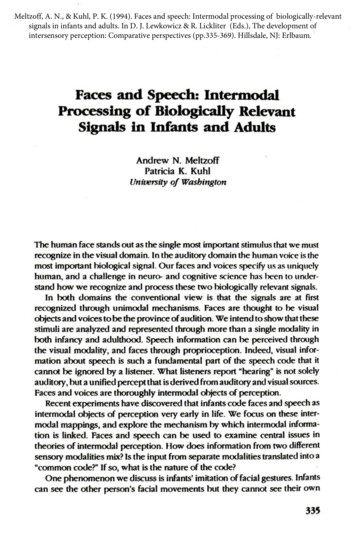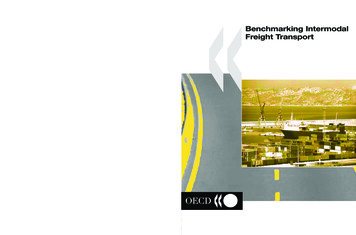
Transcription
European Journal of Interdisciplinary Studieshttp://doi.org/10.24818/ejis.2018.02The Impact of Intermodal Connectivity of Transport Networks on NetExports in the European Union Member StatesCezar TECLEANThe Bucharest University of Economic Studies, RomaniaDoctoral School of Economics and International Businesscezar10tc@yahoo.comAlexandru FOTIAThe Bucharest University of Economic Studies, RomaniaDoctoral School of Economics and International Businessalexandru.fotia@gmail.comAbstractIn this paper we propose to evaluate the impact of intermodal connectivity of transport infrastructure on netexports in the European Union. In this context, we will test the hypothesis that the intermodal capacitydevelopment has the effect of increasing net exports. The impact assessment pursues two objectives:quantifying the extent to which intermodal connections help the balancing of net exports of European statesand identifying the areas where infrastructural deficit has an impact on trade deficit in order to prioritizethe infrastructure development interconnections. The volume of net exports is influenced by the degree ofinterconnection of transport infrastructure, which gives the intermodal nodes the role of cohesion agents atthe community level. On the other hand, the integration into the global economy fosters improvements innet trade, fact revealed by the correlation between the KOF Index of globalization and the values of netexports.Keywords: transport infrastructure; intermodal connectivity; net exports; EuropeanUnion;JEL Classification: F14; O18; R41;1. IntroductionThe net export (balance of trade) is an index that shows an economic relevance on both itssides, as trade surplus and a trade deficit. As a trade surplus, the net export represents oneof the main economic growth “engines”, seen as an essential contributor for the currentaccount and Gross Domestic Product (GDP) creation, fact that explains the pro-exportmeasures and strategies adopted by all governments. The trade surplus volume in theEuropean Union has grown 3.7 times between 2007 and 2016, and this trade explosionhas determined a significant pressure on the transportation network that sustains thegoods and services stock. But the national net exports geography is highly unequal in theEuropean space. Given the fact that the capital investments in many of the Europeanstates have a limited level (Bellak et al., 2010, p.38), exports stimulation and thetransition from a trade deficit to a surplus remains a desideratum to ensure the economicgrowth for more than half of the European governments.Along with other international trade determinants, the endowment with reliabletransportation infrastructures is a critical advantage for stimulating the commercial flows(Copenhagen Economics and Blomström, 2006, p. 18). The appropriate equipping withtransportation infrastructures as a development and territorial cohesion vector represents,as a matter of fact, a major objective of the European Transportation Policy (European15
Vol. 10 Issue 1 2018Commission, 2013), but in the meanwhile it represents a variable depending on theinvestment capacity and the decisional will of national governments. The positiveconsequences of a good territorial equipping with transportation infrastructures on the netexports improvement are the elements broadly acknowledged in the real economy, butalso in the scientific literature, which focuses its attention on the interrelations betweenthe two measures.According to the latest scientific studies’ tendencies, the aim of this paper is to assess theimpact of the transportation infrastructure intermodal connectivity on the national netexports in the European Union space. In this context we are not going to approach thetransportation networks in their function as material infrastructures linked to production,as they are treated in the industrial economy studies (Gramlich, 1994, p. 1178), but fromthe perspective of their interconnection and accessibility agents, a quality which theyoffer to the commercial flow run.The intermodal connectivity is given by the existence of network nodes wheretransportation lines belonging to different types of infrastructures (road, railway, airway,fluvial, maritime) meet. For every network type we will consider the followinginfrastructural elements: the highway network, the high speed railway network (that allowover 200 kph running speeds), national airports and maritime and fluvial harbours.The approached paradigm postulates that the national policies in the transportation fieldswhose consequences are the development of intermodal connections will have effects inthe net exports volume growth, which are also influenced by the degree of integration ofnational economies into the global economy.The results of this undertaking highlight the relation between the inter-connectiveinfrastructures and the net exports volume. In the European Union the accents putdifferently on the connection infrastructure development have a correspondent in the netexports value differences on the European Union’s economic map, even though thecommercial balance improvement is a declared aim of all the European governments.Also, the increased integration into the global economy catalyzes net exports, but at amore reduced pace and magnitude than the intermodal transport infrastructures.The paper is structured as follows: first section introduces the scientific knowledge andthe theoretical accumulation in the field of transportation infrastructure impact on trade;the second section depicts the various data categories used to quantify the net exports andthe intermodal connection infrastructures and also the methodological tools used for theimpact analysis; section three displays the research results and in the end one can find theconclusion.2. Theoretical BackgroundNot only the transportation network interconnectivity but also the balance of trade aremajor interest elements for the regional and market development studies. They alsorepresent an evaluation subject at the national and community decision-makers’ level tounderlie the normative regulations. Though, the relation between the two parameters wasless approached in the literature, in comparison with the studying of the impact of othertrade determinants (market factors, the exchange rate, the foreign exchange, foreigncurrency reserves, inflation, productivity etc). The fact is owed partly to the absence of16
http://doi.org/10.24818/ejis.2018.02European Journal of Interdisciplinary Studiesdata and significant variables referring to the transportation networks intermodalconnections.The role of intermodal connections in the net exports dynamics is analyzed mostly interms of impact on the investments generating exportable production according to theacademic literature. The research attention is focused on the infrastructure equipment as apremise for the production investments (Bellak et al., 2010, p. 40, Apud Richter et al.,1996) and for export easing. Other references presume the fact that a transportationinfrastructure development can determine a disinterest for the local firms to externalizetheir production (Egger and Falkinger, 2006, p. 2003), which may lead to increasing theinternal production and hence increasing the exports volume. In their quality ofdeterminant factors for the spatial economy (Rietveld and Bruinsma, 1998, p. 7), thetransportation infrastructures matter as size, distribution, surface, but also as intermodalconnections through which the transportation cost reduction and the trade volume growthare ensured (Macharis et al., 2010, p. 557; Bensassi et al., 2015). The actual spatialeffects observed during the case studies show that the most elevated sensitivity of exportsin relation to the transportation networks characteristics is registered for the border andcoast regions, where the positive border effect is owed to the reduced distances and theintermodal nodes in the harbours (Bensassi et al., 2015, p. 57).The results of some recent empirical research show that the interconnected developmentof the transportation networks determines in an indirect way the exports volume growth.According to the impact study realized by Tong et al. (2014), the accessibility given bythe highway networks would cause weak effects on the economic growth (GDP),meanwhile economic growth determines effects, with a multiple years delay, on thetransportation infrastructures development. At the same time the transportation and nontransportation infrastructures development has a cumulative impact on the exportsgrowth, also with a certain delay. In fact, the authors consider that the broadening oftransportation networks and intermodal connections has an indirect effect in the exportsand economic growth, effect that is mediated by two intermediate measures: thetransportation infrastructure generates at first the development of public nontransportation infrastructures and private capital accumulation (Tong et al., 2014, p. 73),which, at their turn, determine in a second phase the GDP and exports growth.Consequently, the evaluation of economic benefits resulted from the intermodalconnection of the networks (for example, between the highways and harbours), or fromthe highway building in regions with the highest probability to stimulate the privatecapital accumulation is recommended; the evaluation under scrutiny can fundamentgovernmental decisions to prioritize the budgetary allocation to create intelligenttransportation systems, in order to optimize traffic (Tong et al., 2014, p. 76-77).Starting from the assumption that the positive influence of transport networks on trade isgiven by infrastructure quality and transport costs, Limão and Venables (2001) quantifiesthe elasticity of commercial flows according to the cost of transport and demonstrates thatthe decline in transport infrastructure in the second the third quartile in terms of qualitydetermines the increase in transport costs by 12% and reduces the volume of net exportsby 28% (Limão and Venables, 2001, p. 451). At the same time, improving the quality oftransport logistics from the 25th to the 75th quartile would be equivalent to the impact of a5,000-mile decline in geographic distance and would generate an increase in bilateraltrade between states by 25% (Clark et al., 2004, p. 23); in the case of air transport, thesame improvement rate would result in a 15% reduction in transport costs (Micco andSerebrisky, 2004). By a similar algorithm, Martinez-Zarzoso calculated that for Spain 1%improvement in contact infrastructure would lead to a 0.14% reduction in transport costs17
Vol. 10 Issue 1 2018and an increase of 1.65% in exports of ceramics products (Martinez-Zarzoso et al., 2003,p. 187). The most obvious evidence of the influence of transport accessibility on traderesults from the comparative assessment of the trade of coastal states and of those withoutsea opening. In the 1990s, coastal countries recorded an average net contribution of 28%in GDP formation, compared with 11% in the case of low-income economies; between1965 and 1990, between the top 15 exporting countries in the world, 8 were island states,including the United Kingdom from the European Union and none without a sea opening(Limão and Venables, 2001, p. 451 Apud World Bank, 1998). At the same time, under thecurrent conditions of global trade liberalization, transport costs constitute a more severetrade barrier than protectionist taxes and tariffs (Limão and Venables, 2001, p. 452).Bensassi et al. (2015) quantified the role of expanding interconnected transport networkson the volume of exports through composite indices, namely land infrastructure index andlogistics performance index. By applying the above mentioned indicators, the authorestimated that, in the case of Spain, the increase in the space distribution of infrastructuresfrom the 25th to the 75th quartile had the effect of increasing exports by 35% (Bensassi etal., 2015, p. 54).In order to improve the transportation infrastructure quality – essential to the net tradegrowth, especially for the less developed countries, Nordas and Piermartini (2004)proposed the solution of streamlining the harbour infrastructures as the key to increasingthe participation in the global trade of the states under scrutiny. In the context of lack offinancial possibilities for the governments of these countries to exhaustively develop theirtransportation networks, van Klink and van den Berg (1998) and Sanchez et al. (2003)state that the costs for improving the harbour infrastructures are more permissive and canserve as an engine for pulling out of underdevelopment the problematic economies andnot only (van Klink and van den Berg, 1998, p. 2; Sanchez et al., 2003, p. 205). Multiplecase studies reveal that in the European Union the inter-connexive role of the harbours isundoubtedly to encourage the exports in the hinterlands they serve (Acciaro et al., 2016),significant being the cases of the German Hanseatic harbours which will maintain thetrading competition in the North Atlantic basin (Twrdy and Batista, 2016, p. 138;Paradigma Gmbh, 2014) and which succeed in competing the Italian ones in the Southdespite the geographic distance (Acciaro et al., 2016, p. 343; SRM, 2015, p. 133; Ferrariet al., 2011, p. 382). The harbours’ developments as intermodal nodes would allow later,according to a gravitational model, the industrial areas emplacement next to them tofacilitate exports (Nordas and Piermartini, 2004, p. 18). The gravitational model itemscalculation allowed Donaubauer et al. (2015, p. 9) to show that the positive relation of thetransportation infrastructures on the trade exchange is governed by causality effects, nonlinear reversible, quantifiable through an index which measures the trade relationsbetween the member states in a free-change agreement. The significant innovativecontribution of the Donaubauer index resides in the fact that it takes into consideration therole of the political elements in evaluating the transportation network impact on trade(Donaubauer et al., 2015, p. 18). In the European Union’s case, with more developmentspeeds, the mentioned model could be applicable for the less developed member states ofthe “second speed European belt”. Following some empirical studies made on thebilateral exchanges, Francois and Manchin (2013, p. 165) demonstrate that theinterconnected transportation networks represent both a trade multiplier factor and a tradegenerator. Previously, the authors had shown that the political factor, through the qualityof the institutional environment, plays a decisive role both in configuring somecompetitive transportation networks and a feasible normative frame for catalyzing exports(Francois and Manchin, 2006, p. 23).18
http://doi.org/10.24818/ejis.2018.02European Journal of Interdisciplinary StudiesThe most pregnant input brought by the growth of interconnected infrastructure quality isregistered in the less developed economies, where, as Wilson appreciates, the harbour andairport infrastructures’ improvement, but also the business facilities, would increase theglobal trade volume with 377 billion USD (Wilson et al., 2005, p. 841), and a decrease inthe transportation of goods costs with 10% as a consequence of a good intermodalintegration of the networks would cause a 4.4% increase in the global trade (MárquezRamos et al., 2011, p. 569). Also, according to Coca-Castaño et al., the improvement ofthe informatics assisting process of the interconnected infrastructures – intelligenttransportation type, is responsible for a significant increase of the trade exchanges (CocaCastaño et al., 2005, p. 18).Considering the last four decades of international trade continuous growth context,Blonigen and Wilson (2013) appreciate that there is also a reverse determination relation,respectively the trade growth bears pressure on the transportation network development,especially of the maritime and harbour infrastructures. These are the most appropriate tobe used as intermodal connection nodes to ensure the commercial flows’ run (Blonigenand Wilson, 2013, p. 630), responsible for maintaining the big harbours in the WesternEurope as the main “hubs” of export-import of the European Union.3. Empirical Approach3.1. Data and measurement of net exports and intermodal connectivityIn order to measure the balance of trade (net exports), we will take into account theaggregate net exports of goods and services for each European Union member state at2016 values. This paper uses data on net exports of world states obtained from the OECDData (OECD, 2016). The use of cumulative data for the net export of goods and servicesoffers the advantage of unitary quantification of the relationship between transportnetworks’ interconnections and total trade balance. However, this approach also haslimits in terms of the absence of a separate assessment of the impact of infrastructure onnet exports of goods and net exports of services. In spite of this, the assessment allows usan integrated perspective on the impact of intermodal infrastructures in the configurationof national current accounts.The intermodal connectivity, expressed by the number of intermodal nodes, wasdetermined by the authors by interpolation of the categories of transport networks(motorways, high-speed railways), starting from international airports and ports, asreference interconnection nodes. We will analyze the impact of intermodal capacities onnet exports through three parameters that we have designed to evaluate the impact onnetworks integration levels: Intermodal nodes of the first order (main nodes) interconnect the infrastructureelements of all four categories of network (highways, high-speed, airports, ports). The 54main nodes identified in European Union are major international ports and airportslocated exclusively within the trans-European network TEN-T and are the main exportimport hubs in European Union (Heijman et al., 2017, p. 352); they play a major role asdevelopers for the regions they polarize, but contribute to the creation of large economicdivergences in the community space (Rotter, 2004, p. 362) because the other nonequipped spaces with such connections lag behind them. Intermodal nodes of the second order (412 intermediate nodes) interconnectelements of three out of the four categories of networks.19
Vol. 10 Issue 1 2018 Third order intermodal nodes (870 primary nodes) interconnect the infrastructureelements of two out of the four categories of networks and provide basic synapses oftransport networks across the continent. Their relevance in the network derives from thefact that, although they do not have the polarizing valences of the first and second ordernodes, they are the most widespread in the territory and thus contribute to theinterconnection of the less developed regions and to the reduction of the interregionalcleavages.The table of the intermodal connectivity supply of the transport infrastructure comparedto the net exports of the European Union member states (Table 1) highlights both directand indirect correlations, analyzed in the next section of this paper.Table 1. Intermodal connectivity of transport networks and net exports ofEuropean Union countriesTrade balanceIntermodal connectionsTotal number of 50intermodalconnections20-49 20Excess trade balanceGermany, Spain, Italy, Belgium,Netherland, Austria, SwedenDenmark, Poland, PortugalBulgaria, Czech Rep., Estonia, Ireland,Croatia, Latvia, Lithuania, Luxembourg,Hungary, Slovenia, Slovakia, MaltaNumber of first 3Germany, Spain, Italy, Netherland,order intermodalSwedenconnections1-2Belgium, Denmark, Austria, Poland,Portugal0Bulgaria, Czech Rep., Estonia, Ireland,Croatia, Latvia, Lithuania, Luxembourg,Hungary, Malta, Slovenia, SlovakiaNumber of second 10Germany, Spain, Italy, Netherland,order intermodalSweden, Belgium, Denmark, Austriaconnections5-9Ireland, Poland, Portugal 5Bulgaria, Czech Rep., Estonia, Croatia,Latvia, Lithuania, Luxembourg, Hungary,Slovenia, Slovakia, MaltaNumber of third 30Germany, Spain, Italy, Netherland,order intermodalBelgium, Sweden, Austriaconnections10-29Portugal, Denmark, Ireland, Poland 10Bulgaria, Czech Rep., Estonia, Croatia,Latvia, Lithuania, Luxembourg, Hungary,Malta, Slovenia, SlovakiaSource: Authors’ own representation using data from OECD (2016)Deficit trade balanceFrance, United Kingdom,FinlandGreeceCyprus, RomaniaFrance, United Kingdom,GreeceFinlandCyprus, RomaniaFrance, United Kingdom,Finland, Greece–Cyprus, RomaniaFrance, United Kingdom,FinlandGreeceCyprus, RomaniaTerritorial equipment with intermodal nodes projects a European Union with moreinterconnection “speeds” (Figure 1), according to the following model: well-interconnected transport infrastructure (with more than 50 intermodal nodes,of which at least 3 of them are of the first order) generally have a surplus tradebalance (Germany, Spain, Italy, the Netherlands, Belgium, Austria, Sweden);exceptions to the rule, such as France, the United Kingdom or Finland, whosetrade balance is severely deficient, are due to other specific economic factors. most of the medium-interconnected spaces of transport networks (20-50intermodal nodes of which at least one of the first order) also have an over-tradebalance (Denmark, Poland, Portugal) and for the exception of Greece the deficientnet export is due to internal economic factors.20
http://doi.org/10.24818/ejis.2018.02 European Journal of Interdisciplinary Studiescountries with poor intermodal connections (less than 20 intermodal nodes and nofirst level connections) comprise 12 states integrated after 2004 (except Poland)plus Ireland and Luxembourg; they register a trade surplus balance, with theexception of Cyprus and Romania.In order to estimate the degree of integration into the global economy, we will take intoaccount the values of KOF Index of globalization for each European Union member state,obtained from the KOF Swiss Economic Institute database (Gygli et al., 2018).Figure 1. Distribution of intermodal connections and national net exports in EUSource: Authors’ own representation using data from OECD (2016)21
Vol. 10 Issue 1 20183.2. Methodological aspectsOur research hypothesis states that government decisions for the development ofintermodal transport capacities, along with the degree of global economic integration,have the effect of increasing net exports.In this context, the main objective of our approach is to show to what extent theintermodal connections of transport networks contribute to balancing the trade balance. Asecond objective is to identify the areas where the infrastructure deficit places its mark onthe trade deficit, in order to prioritize the development of interconnected infrastructure atdecision-makers level.In order to estimate the impact, we will use an econometric gravitational model consistingof two sets of linear regressions similar to those used by Nordas and Piermartini (2004),but different by the linear and not logarithmic character of the equations. In the firstregression, the number of intermodal nodes represents the independent variable, and thenet exports of European Union member states is the dependent variable. In the secondmultiple regression, we will quantify the influence of the intermodal connections andglobal economic integration on the net trade growth; in this equation the values of thenational net exports are the dependent variable and the number of intermodal nodes andthe values of the KOF Index of globalization are the independent variable.In this section we present the gravitational model with its equations, and in the nextsection (“Results and Discussion”) we evaluate and interpret the regression results. Theequations of the two sets of linear regressions will be the following:y ax b ɛₑwhere: y - net exports (dependent variable);x - number of intermodal nodes (independent variable);a, b - regression coefficients;ɛₑ - regression residuals.(1)y ax bz c ɛᵢwhere: y - net exports (dependent variable);x - number of intermodal nodes (independent variable);z - KOF Index of Globalization (independent variable);a, b, c - regression coefficients;ɛᵢ - regression residuals.(2)Specifically, we will use the value of regression coefficients and residuals to customizefor each European Union member state the contribution of interconnected infrastructuresand global integration to net exports. The adjusted correlation coefficient (adjusted R²)gives the average share of the influence of intermodal capacities and global integration onnet exports at community level. The regression coefficients provide information on theadded value of each intermodal node to the net export volume. The value of theregression residuals gives the measure of the “weight” of the intermodal infrastructuresand the level of integration into the global economy in the net export configurationcompared to other determinants. Mapping of residual values provides significantindications of spaces for which the improvement of interconnection links and deeperglobal integration would lead to an improvement in the trade balance.22
European Journal of Interdisciplinary Studieshttp://doi.org/10.24818/ejis.2018.024. Results and DiscussionAs shown in the previous section, we apply the gravitational analysis model in the twospecific situations: the impact of intermodal transport network connections on net exportsand the cumulative impact of intermodal connections and degree of global economicintegration on net export volumes.4.1. The impact of intermodal connections on net exportsThe gravitational econometric assessment reveals a significant link between thedevelopment of interconnected infrastructures and national trade balances for eachmember state (Table 2).Table 2. Table of net exports regression of European Union countriesdepending on intermodal connections of transport networksRegression StatisticsMultiple R0.324634355R Square0.105387465Adjusted R Square0.07097929Standard CoefficientsInterceptTotal Intermodal (no.)3.5200.309MS7775.4348442538.618039Standard Error12.7310.177F3.06286126Significance F0.091895114t Stat0.2761.750P-value0.0480.032Figure 2. The relationship between the net exports of European Unioncountries and the intermodal connections of transport networksTrade Balance (billion USD)300250200y 0.309x 3.5198150Adj R² 0.07100500050100150200-50-100Total Intermodal (no.)Source: Authors’ own representation using data from OECD (2016)23
Vol. 10 Issue 1 2018The relationship between the two parameters is valid (Significance F 0.09189) and theequation of the linear regression is (Figure 2):y 0.309x 3.52 ɛₑwhere: y - net exports;x – no. of intermodal nodes;ɛₑ - residual of net exports’ regression.(3)According to the positive value of the coefficient a 0.309, the correlation between thevolume of national net exports and the number of intermodal nodes is direct and positiveat the European Union level, and each existing or configured intermodal node accountsfor USD 309 million in the trade balance. Theoretically, if there were any state in theEuropean Union (non-existent situation), its trade balance would be only USD 3.52million (according to the coefficient b 3.52), plus the value of the residual for theconcerned state (ɛₑ).Residuals of regression (ɛₑ) represent the most interesting parameter of evaluation andinterpretation, as they measure the influence of other factors which contribute together, aswe have seen, 93% of the trade balance. The calculated residual values vary over a widerange, from a maximum of 19.9 for Germany to a minimum of -10.1 for the UnitedKingdom. Such eccentric values reflect, as we have seen, a particular dynamics of theeconomic situation resulting from a much more substantial contribution of market andproductivity factors than infrastructure. For this reason, it is more interesting to evaluatethe spatial distribution of residuals by removing the three states (Germany, UnitedKingdom, France) from the analysis that we will continue to perform.The value of the adjusted R² coefficient (0.07) highlights that intermodal transportnetwork links account for 7% of national net exports. It is a relatively small share, whichhighlights the major role of other determinants (market factors, exchange rate, foreignexchange reserves, inflation, labour productivity), which contributes 93% to the tradebalance. At the same time, the graph of the equation renders an exaggerated dispersion ofthe corresponding values for states with high commercial surplus (Germany) or withmajor trade deficit (United Kingdom, France); this phenomenon distorts the results of theassessment, namely it diminishes the impact of intermodal connections on net exports.In this context, we made a new regression by excluding the three mentioned states,resulting in a more homogeneous regression model (Table 3).Table 3. Table of net exports regression of EU countries’ intermodalconnections of transport networks, excluding Germany, France and the UKRegression StatisticsMultiple R0.580933187R Square0.337483368Adjusted R Square0.308678297Standard 3700.09652315.8127274F11.716109Significance F0.002325831
European Journal of Interdisciplinary ptCoefficients3.963Standard Error4.646t Stat0.853P-value0.040Total Intermodal (no.)0.2920.0853.4230.002In this case, the equation of linear regression is (Figure 3):y 0.291x 3.963 ɛₑwhere: y - net exports;x – no. of intermodal nodes;ɛₑ - residual of net exports regression.(4)Figure 3. The relationship between the net exports of European Unioncountries (excluding Germany, France and the UK) and the intermodalconnections of transport networksTrade B
The intermodal connectivity is given by the existence of network nodes where transportation lines belonging to different types of infrastructures (r oad, railway, airway, fluvial, maritime) meet. For every network type we will consider the following infrastructural elements: the highway network, the high speed railway network (t hat allow .


